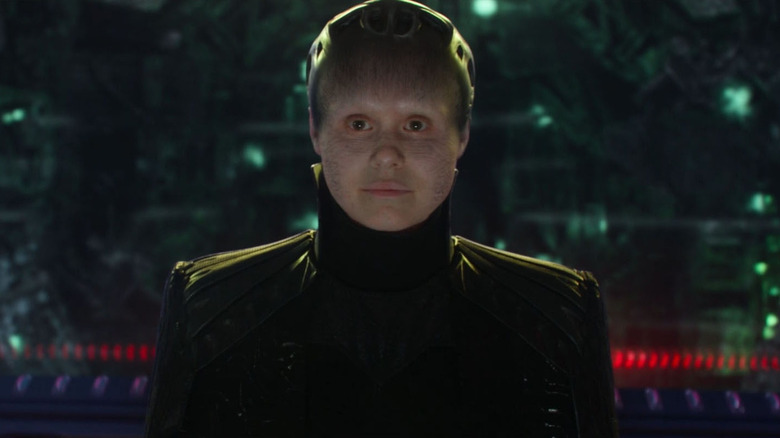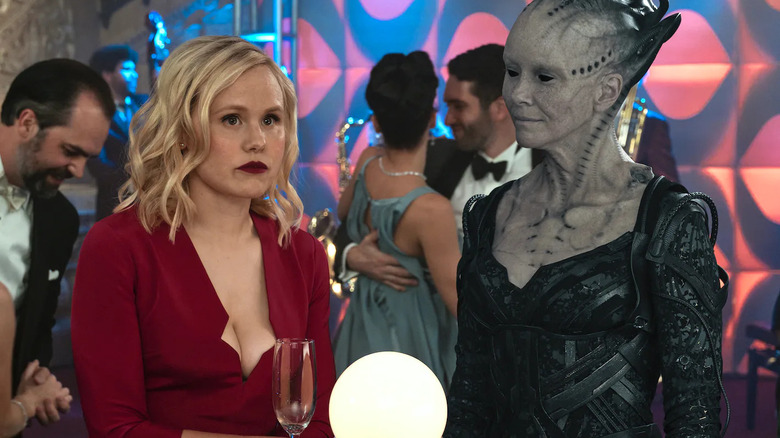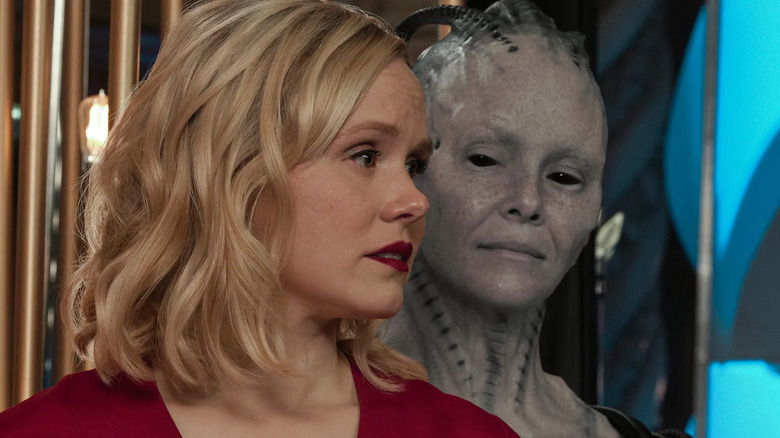Star Trek: Picard Season 3 Undoes One Of Season 2's Biggest Sins
This post contains spoilers for the latest episode of "Star Trek: Picard" season 3.
When the Borg first appeared in "Q Who" (May 8, 1989), an episode of the second season of "Star Trek: The Next Generation," they instantly became a tantalizing and threatening antagonist throughout Trek's galaxy. At the end of the show's third season, the Borg returned and assimilated Captain Picard (Patrick Stewart) into their collective in "The Best of Both Worlds" (June 18, 1990), often hailed as one of the best episodes of the series. To that point, the Borg remained threatening, cold, unthinking, awesome villains.
In the 1996 feature film "Star Trek: First Contact," however, the Borg were ... altered. They became animal, malevolent, and sweaty. Additionally, they now had a queen (played by Alice Krige) who expressed emotions, and — most frustratingly — could be negotiated with. The idea of the Borg being fallible, emotional beings made them a lot less threatening. The non-threatening Borg would be carried over into "Star Trek: Voyager," which saw many instances of people being extracted and de-assimilated. Captain Janeway (Kate Mulgrew) even allowed herself to be assimilated at one point. By then, the Borg were about as effective as a G.I. Joe villain.
The second season of "Star Trek: Picard" saw the lowest point for the Borg yet. At the beginning of the season, a mysterious Borg ship appeared through a space hole. A Borg queen (wearing a mask) appeared on the bridge of the U.S.S. Stargazer, and began assimilating it with Dr. Octopus tendrils. In that instant, Picard (Patrick Stewart) was instantly whisked away to an alternate universe and the main story of the season would play out over nine episodes before returning to that Borg queen.
The actual reveal was supremely stupid.
The Jurati Borg
Throughout the second season of "Picard," Dr. Jurati (Alison Pill) butted heads with that universe's evil Borg queen (the late Annie Wersching), and the Borg queen ended up assimilating Jurati's mind. This was, thanks to a time warp, all set in the year 2024. When the series returned to the future, it was revealed that Dr. Jurati had been a Borg queen for centuries, and was only assimilating the Stargazer because she needed a fleet of starships to stop a massive and destructive spatial phenomenon that was, prior to that instant, never mentioned. The Jurati Borg explained that unity, diplomacy, and working together was the new ethos of the Borg. "Picard" implied that the Borg — the entire species — had turned over a new leaf and that they wouldn't be villains anymore.
Thanks to the new season of "Picard," however, it seems that Jurati's "kindler gentler Borg" were a one-off fluke, and that the Borg have been left intact as a soulless species of conquering cyborgs. Thank goodness.
On the latest episode of "Picard," called "No Win Scenario," Captain Shaw (Todd Stashwick) is taking a load off in the holodeck before he and his crew are likely to be destroyed inside a destructive nebula. Because he is a massive jerkwad (but, y'know, respectable), Shaw points out to Picard that the latter was once assimilated, and that he was at least indirectly responsible for the 11,000 deaths at the Battle of Wolf-359 (Shaw barely escaped with his own life, and has the emotional scars to prove it). Although Shaw's first officer was once Borg (Jeri Ryan's Seven of Nine), he doesn't have a rosy view of them. "The Borg are still out there," he says, implying that the Jurati Borg was but a fluke.
Importantly, Shaw says "Forget that Stargazer s***," directly contradicting the finale of season 2.
'Forget that Stargazer s***.'
All of the controversy about the malleability of the Borg may be traced back to a "Next Generation" episode called "I, Borg" (May 10, 1992). In that episode, the Enterprise discovers a single Borg drone that had survived a shipwreck on a distant planet. They bring the drone back on board, start conversing with it, and name it Hugh (Jonathan Del Arco). They find that when they separate a Borg from its collective, it begins to develop a sense of individuality. Ultimately, the Enterprise crew send Hugh back to the Borg to be re-assimilated, all by his own choice.
One might think that the Borg would have no issues with erasing their own drone's memory, but Hugh returned in a two-part episode called "Descent" (September 20, 1993). That episode revealed that Hugh's sense of individuality spread throughout his Borg ship, transforming them into lost souls seeking a leader. It seems that pulling people out of the Borg collective is pretty easy. Indeed, the Borg are varied and nuanced and can be talked to. Between "Descent," "First Contact," and "Voyager," the Borg were no longer dramatically threatening. Thanks to "Picard," they weren't even villains anymore.
A single line of dialogue in "No Win Scenario," however, undoes most of that. The Borg, it seems, are just as Borg as ever, somewhere out in the galaxy. Decades after the events of "Best of Both Worlds," humanity is smarting from the battle at Wolf-359. All the strange screenwriting aberrations Trekkies have witnessed over the years have been just that: aberrations. The Borg will still assimilate you, still operate coldly, still think like machines. For the Borg, evolution is antithetical to their character. It's nice to know that somewhere, they haven't evolved.


